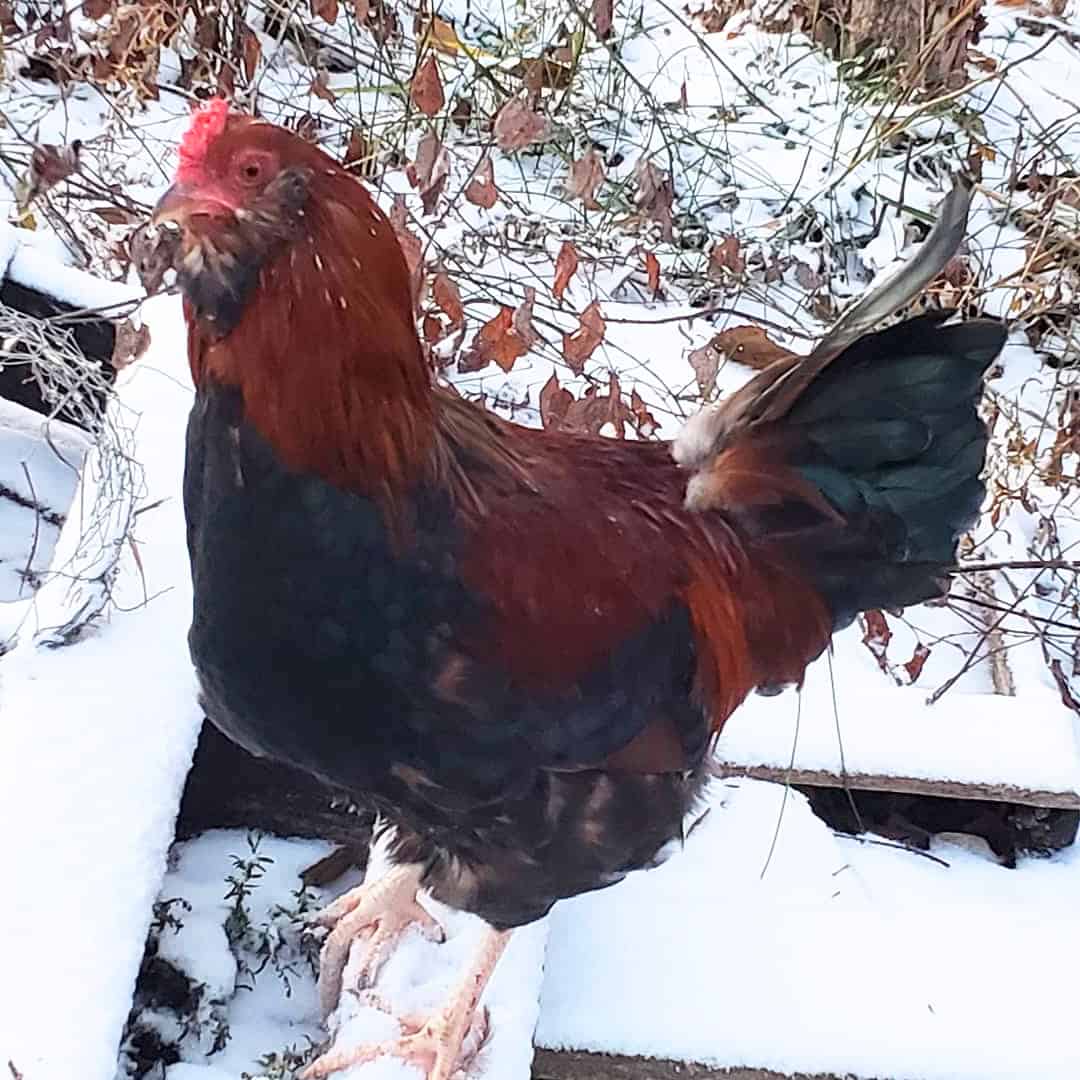Last Updated on December 29, 2024 by Alice Benny
Technically speaking, chickens are cold-hardy animals that can tolerate temperatures just below freezing. However, just because they are cold-hardy doesn’t mean they don’t get cold. Learning how cold is too cold for chickens will help you learn how to keep your chickens warm in winter.
As a chicken owner in an area that sees harsh freezing temperatures during winter, you must learn how to keep your chickens warm through the colder temperatures. In some cases, farmers prefer using some kind of heat source, such as heating plates or heat lamps. While this can work fine when set up properly and safely, other methods can help keep your chickens warm and prevent heat loss during the winter.
When it’s below freezing, it’s important to not let chickens get wet. Combs are particularly susceptible to frostbite. In addition, if chickens have feathers on their legs and feet, be sure they remain dry.
Even though chickens, especially cold-weather chickens, have adapted and found ways to stay warm in a cold climate, as a chicken keeper, you must find ways to ensure that they can stay warm through winter. A winterized coop is essential.
Learn how cold can chickens tolerate, and what can you do to help keep them warm even without electricity. Read on to learn more. Note, choosing a cold tolerant chicken breed is important if you live in an area with very cold months.
How Cold Can Chickens Tolerate
Chickens can tolerate temperatures below freezing. However, they don’t thrive in this type of weather. The ideal temperatures for chickens lie between 65 and 75 degrees Fahrenheit, but they are often comfortable even when the temperatures range between 40 and 45 degrees.
There are some cold-hardy breeds, such as the Buff Orpington, Rhode Island Red, Icelandic chickens, and Gold Star chickens, that are particularly adapted to extreme cold. However, even these breeds still need some kind of protection from long cold winters. The California White chicken is a hybrid that is cold tolerant with proper shelter and care.
When chickens are active, this increases their body temperature. This can mean the difference between raising chickens that are allowed to free-range or have a chicken run versus chickens who are raised primarily in cages. In cold weather, it is helpful to keep chickens active.
Most chicken breeds can survive in an uninsulated coop without a heat source when it’s below freezing. However, it’s important to learn how to keep chickens warm in winter so they thrive. There are easy things you can do.
Ideal Temperature for Adult Chickens
Ideally, chickens thrive in temperatures around 70 degrees Fahrenheit (21 degrees Celsius). However, they can survive much lower temperatures. Even though they can tolerate the cold, it’s still important to keep the chicken coop warm and dry during cold winter. Keeping them dry will help prevent frostbite. Their shelter needs to be draft-free and well-ventilated.
During very cold nights, you may want to add a single heat source such as a heat lamp. Use a heat lamp with caution. There are safety concerns. It’s important to provide chickens with a heat source so they can use it to regulate their body temperatures. You don’t want to make the entire chicken coop hot. Making their chicken coop too hot will lead to adverse consequences such as:
- Reduced appetite
- Weight loss
- Reduced egg production
- Poor quality eggs
Hens can keep laying eggs even when the temperature is below freezing. There is less light in the colder months, and because of this, chickens lay less frequently or not at all when the days get shorter. Depending on the breed, the egg production rate will reduce, but you will still get some fresh eggs even during winter with many breeds.
Chickens are homeothermic. This means they produce and dissipate their heat to maintain their body temperature. In adult chickens, the variability is between 105°F and 107°F (40.6° and 41.7°C) while a newly-hatched chick has a body temperature of about 103.5°F (39.7°C). It increases each day until they are approximately 21 days old. Another important thing to note is larger chicken breeds have a lower body temperature than smaller chicken breeds.
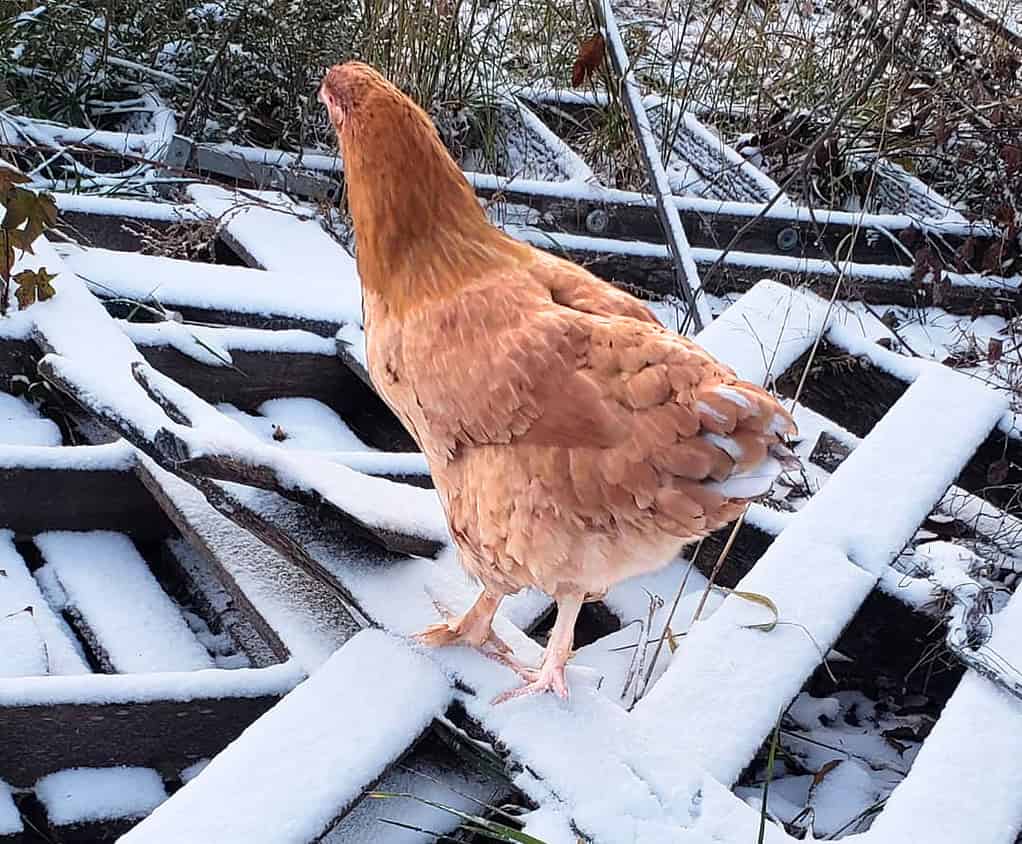
How Cold Is Too Cold for Chickens
When in a winterized coop, (draft free, well-ventilated, warm bedding, chicken manure picked up to not create excess moisture) dry chickens can withstand temperatures in the low digits.
Chickens are well adapted to cold temperatures and some breeds can handle temperatures as low as 0°F, provided they have appropriate shelter, high-energy food to help them generate body heat, and water that does not freeze.
However, prolonged exposure to temperatures below 20°F can be dangerous, especially if the birds are wet or exposed to strong winds. At these temperatures, chickens may experience frostbite or hypothermia, which can lead to illness or death.
Consider also the climate. Cold, dry regions without moisture seem warmer than the same cold temperature in damper climates. Add wind chill, and it’s even colder.
Ideal Temperature for Baby Chickens
As you can imagine, chicks aren’t as cold-hardy as adult chickens. This is due to their immature feathers and smaller structure. Chicks are quite sensitive to the cold during the first few days of hatching, and exposing them to extremely cold weather during this time could lead to illnesses and even death.
As such, it’s important to ensure they are kept in a space with an average temperature of about 90 – 95 degrees Fahrenheit. A good rule of thumb is gradually reducing the temperature by around 5 degrees weekly. Once the baby chicks reach their fifth week, you can maintain the temperature at 70 – 75 degrees Fahrenheit.
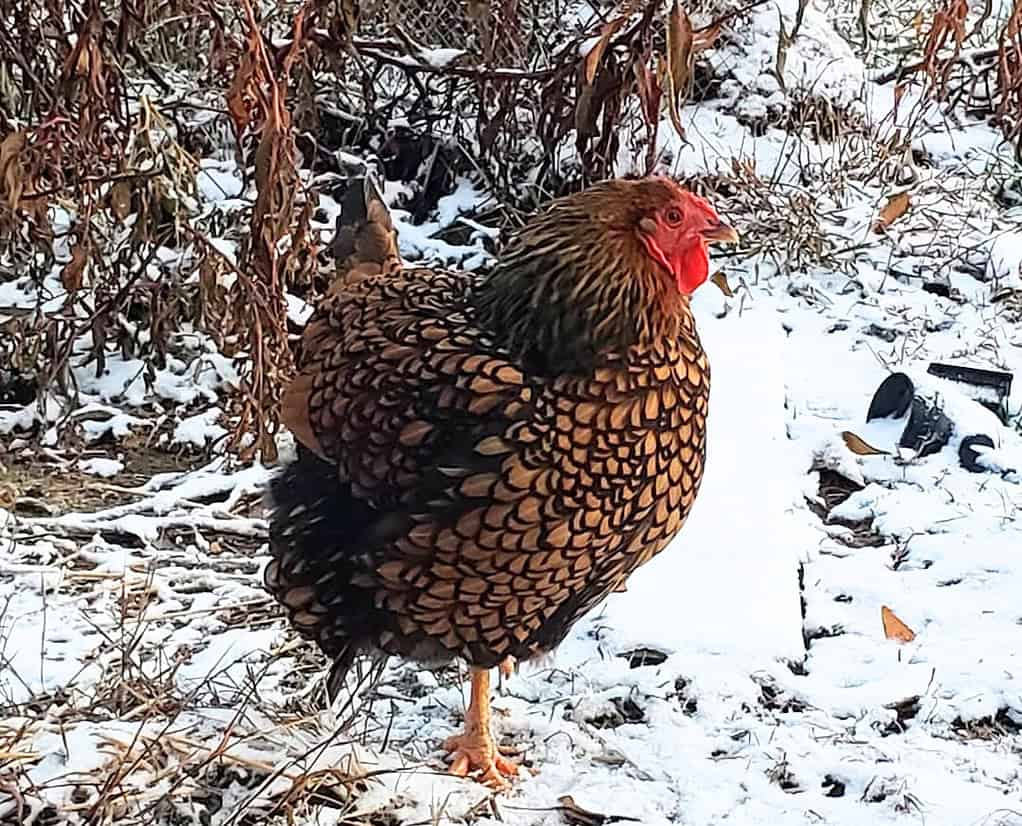
How Do Chickens Keep Warm in Cold Weather?
Before we look at how to keep chickens warm in winter, let’s take a quick look at how chickens keep themselves warm during cold weather. Understanding this will help you find organic ways to provide them with supplemental heat.
Feather Fluffing
Have you ever seen chickens fluffing their feathers when it’s cold? They do that to keep themselves warm. Chickens have downy feathers near their skin, and these feathers trap little pockets of air next to the chickens’ bodies.
The chicken then uses its body temperature to warm these pockets of air. The feathers hold these warmed-up pockets of air next to the chickens’ skin, which essentially keeps any cold air from getting through to that skin. In short, they have found ways to insulate themselves against the cold.
The fluffing is done to trap as much air in there as possible. One of the main reasons many chicken breeds molt during the fall is to have fresh plumage with which they can trap more air in winter.
Get a Leg Up
Most chicken breeds don’t have feathers on their legs. This is the one part of their bodies that can get cold during winter. To counter this, chickens tend to stand on one leg as they pull the other close to and under their feathers by their belly. This allows them to warm up one leg at a time.
One of the best ways to help your chickens stay warm is to provide them with wide roosting bars in their chicken coop. Heat rises, so installing roosting bars closer to the ceiling will help them access warmer air. However, some chicken breeds do not roost.
Chicken Feed
Biologically speaking, living organisms generate heat during digestion. One way to help keep your chicken warm without electricity is to give them food that isn’t as easy to digest during the winter. You can feed them cracked grains or dried corn just before they retire for the evening.
As a result, since these foods are harder to digest, the chicken’s body will use more energy and produce more heat through the night.
Chickens have other tricks to keep warm, such as:
- They tuck their heads under their wings to keep their wattles and combs from getting frostbite
- Keeping close to one another to share body heat
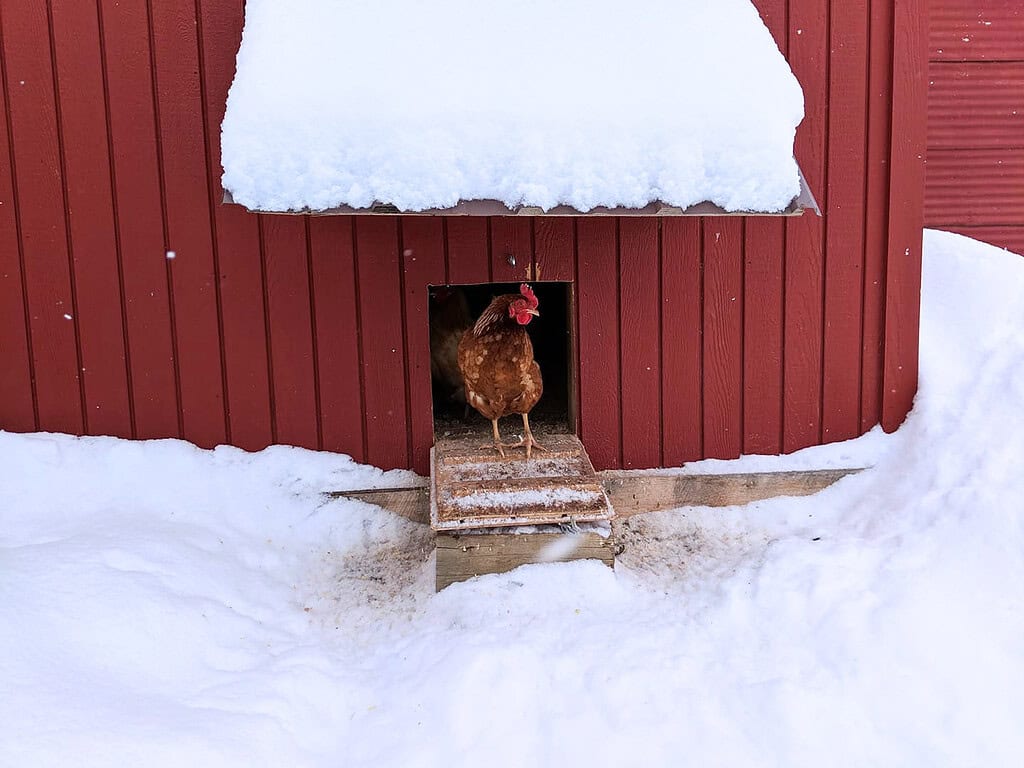
How to Keep Chickens Warm in Winter Without Electricity
If you are looking for ways to keep your chicken warm without electricity, here are some tips and tricks you can try.
- Provide them with food: Make sure your chicken has a constant food supply throughout the day. Chicken tends to burn many calories trying to keep warm in cold temperatures. Since digestion helps generate heat, giving them a steady supply of food will help offset the lost calories and keep them warm.
- Provide warm bedding: You have to ensure that their coop is warm and dry and has lots of warm bedding. Using the deep litter method is a great way of ensuring that your chickens have enough bedding and scratch grain to keep them active and well fed. Providing layers of hay or straw to insulate the ground will help.
- Keep the coop well-ventilated: The chicken coop needs to be well ventilated to keep the chicken cool and allow any moisture to escape. Frostbite can be caused by moisture within the chicken coop during winter.
- Install chicken waterers: It’s important chickens do not get wet when it’s cold outside.
- Provide them with stable roosting bars: These should be available both within the chicken coop and outside. These allow them to stay off the cold ground.
- Dry their combs: Rooster combs and combs on chickens are prone to frostbite. Be sure they stay dry or dry them with a towel. Consider breeds that have large combs such as Leghorn chickens.
- Dry feathered legs and feathered feet: Wet feathers can be a problem in cold temperatures. Cochins, Brahmas, Silkies, and other breeds with feathered feet need to be kept dry.
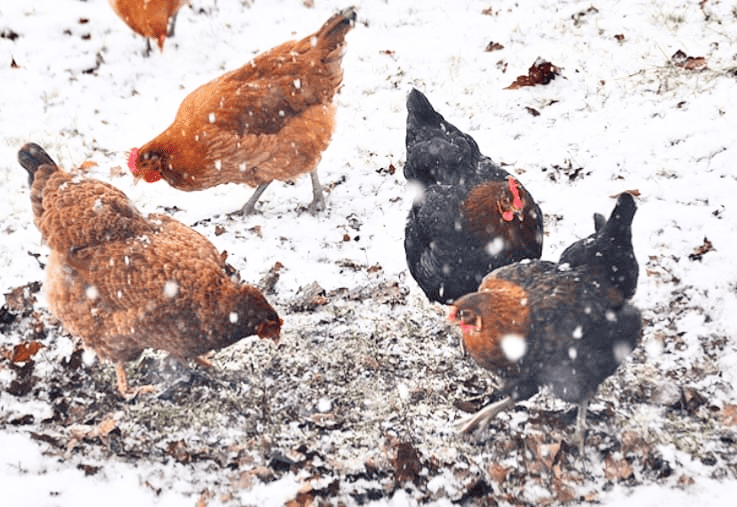
How to Keep Chickens Warm With Electricity
Eventually, however, depending on how bad the winter weather gets in your area, you might need to go the electricity route. When raising backyard chickens, apparatuses such as chicken coop heaters should always be available at the farm. For safety, heating plates are often preferred over heating lamps.
Be sure to keep the space well-ventilated and clean. It is important to warm the air, not heat it. Chickens prefer warm air instead of hot air.
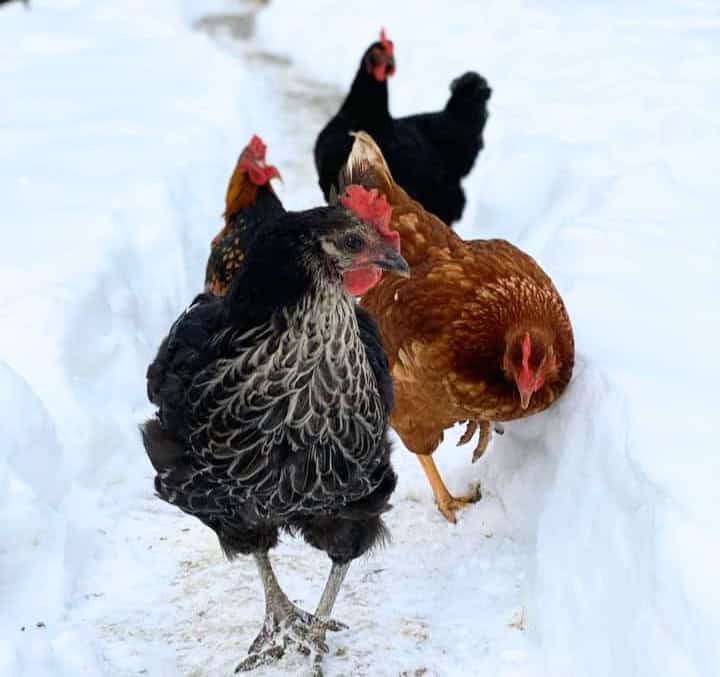
Keeping Chickens Warm in Winter
Depending on the climate where you live, you may need to keep chickens warm during the winter. When you incubate and hatch chicks at home, chicks must be kept warm in a brooder for the first six weeks.
After that, if the outdoor temperature permits, you can begin to transition them outdoors. If a hen is raising her own chicks (or raising another’s), you will need to plan for a warmer space.
So, how cold can chickens tolerate? Chickens can survive below freezing temperatures because they are cold-hardy creatures.
However, they thrive in temperatures around 70 – 75 degrees Fahrenheit and, as such, need to be kept warm during winter. The tips and tricks highlighted here will help achieve that and more.
Learn more:

